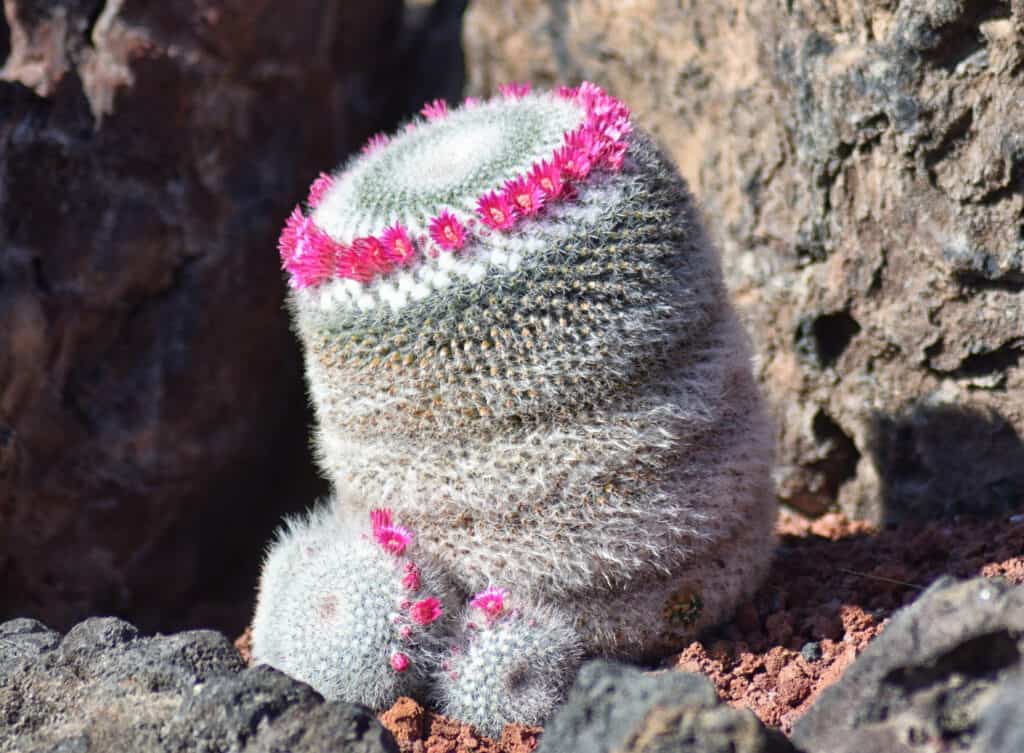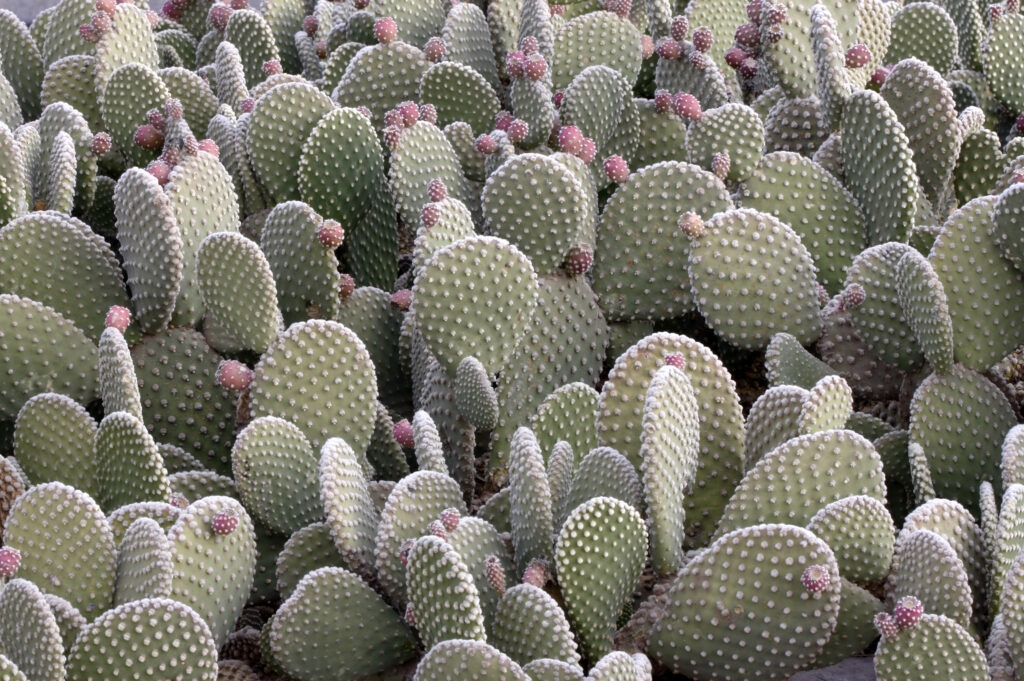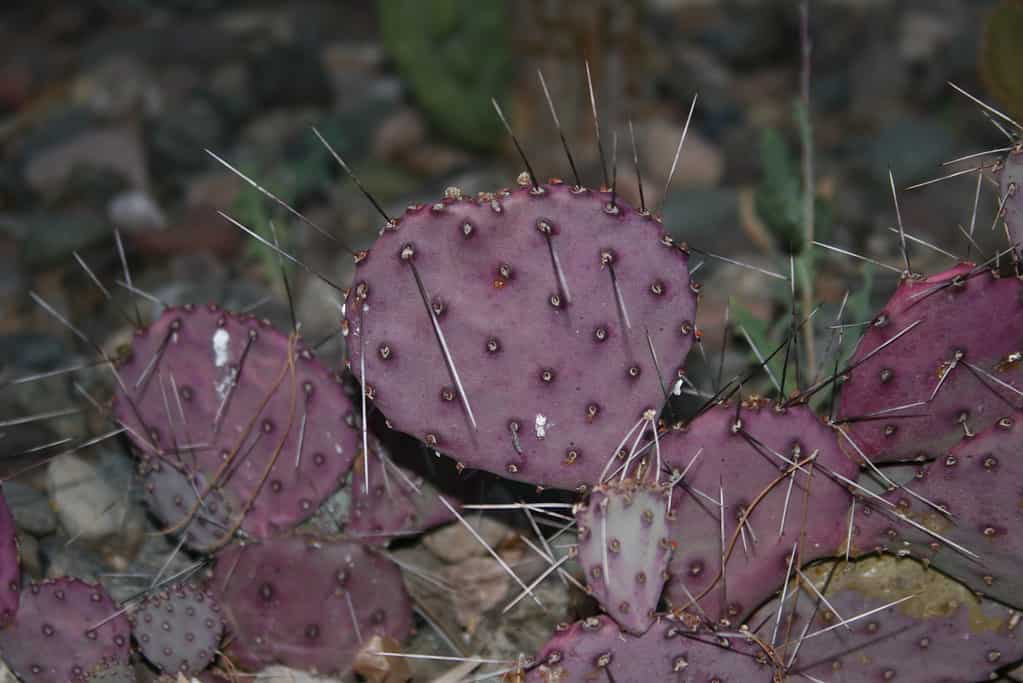Cacti come in all sorts of shapes and sizes. These beautiful succulents are impressive and can grow anywhere, including cool mountains and scorching hot deserts. While many people picture large and tall cacti, these plants can look very different! For instance, not all cacti are green and tall. Some cacti are thin and short. Others are vibrant colors and produce many flowers. Gardeners and cacti enthusiasts love collecting and caring for purple cacti. Follow along to learn about 5 types of purple cacti and their unique traits!
Old Lady Cactus
One of the most popular types of purple cacti is the old lady cactus. Its scientific name is Mammillaria hahniana. This beautiful flowering cactus isn’t entirely purple, but it produces small pink and purple flowers. This cactus is native to central Mexico but is a common container garden plant. It grows well indoors and outdoors with a strong light source.
The old lady cactus belongs to the family Cactaceae. This stunning cactus has many white down and white spines. Its flowers bloom in spring and summer and sometimes wrap around the plant’s thick stem. This cactus can reach about 10 inches tall but usually stops growing between 4 to 5 inches. It’s also a wide plant, typically growing up to 5 inches wide.
Like other cacti, the old lady cactus likes company. It often grows in groups and duplicates quickly. If you decide to grow this stunning cactus, make sure to buy a container large enough. They grow quickly in groups and can die or become stressed if overcrowded. It’s also important you water the cactus as little as possible. These lovely cacti are sun-loving plants that commonly suffer from root rot. Only water your old lady cacti if the soil is completely dry. When you do water your plant, the water must seep through evenly. If there isn’t enough drainage, the roots can drown.

Old lady cacti are beautiful and thick cacti that produce pink and purple flowers during spring and summer.
©iStock.com/Ian Lycett-King
Beavertail Prickly Pear
Another purple cactus on our list is the beavertail prickly pear. Its scientific name is Opuntia basilaris, but this cactus is also known as the beavertail cactus. This plant is native to the southwest United States and northwest Mexico. The beavertail prickly pear cactus grows in hot deserts like the Mojave Desert and the Colorado Desert, however, it also naturally occurs throughout the Grand Canyon.
This small to medium-sized cactus produces vibrant pink and purple flowers. The cactus typically reaches between 2.8 to 15.7 inches tall. The fleshy flattened pads throughout the plant vary in color but are sometimes blue-green or blue-purple.
Although it’s more common to see these cacti in the wild, you can grow them as decorations. They are popular plants in rock gardens. When growing beavertail cactus outside, it’s best to grow it in USDA hardiness zone 8 and up. These plants grow quickly, so while you can grow them in containers, it’s best to choose a large size. If you live in a zone where the temperature drops below freezing, in winter, you may need to bring your beavertail prickly pear cactus indoors.
One of the best parts about having your own beavertail prickly pear cactus is that propagation is super easy. Just take one of the pads and set it aside until it grows a callus. Then plant it into a container with soil.

Beavertail prickly pear cacti are native to the southwest United States and northwest Mexico.
©Steve Bower/Shutterstock.com
Purple Prickly Pear
The purple prickly pear cactus is one of the most well-known cactus plants in the world. The scientific name for this cactus is Opuntia macrocentra. It’s also commonly referred to as the long-spined purplish prickly pear, black-spined prickly pear, and redeye prickly pear. This beautiful cactus is native to the southwest United States and northwest Mexico. You can find these plants in states like Arizona, New Mexico, and Texas. Purple cacti are rare and this unique cactus develops a purplish stem.
Purple prickly pear cacti spread wide and produce stunning large colorful yellow and red flowers. The plant also has delicious dark red fruits. While these plants spread wide, they are slow growers. They also live in many habitats including sandy desert flats, rocky hills, and valley grasslands.
Purple prickly pear cacti can grow up to 3 feet tall, but they usually stop growing at about 1 to 2 feet. While this cactus is purple, the shade varies. For instance, it’s most purple at the edges of the pad. These plants appear more purple when stressed or exposed to the cold.
If you choose to grow this stunning cactus, know that it requires at least six hours of direct sunlight per day. The purple prickly pear cactus is easy to grow. It’s low maintenance and only requires watering when the soil is dry.

The purple prickly pear cactus produces beautiful purple pads and delicious dark fruit.
©iStock.com/Shadow_Hawk
Santa Rita Prickly Pear
Another purple cactus on our list is the Santa Rita prickly pear. This beautiful plant stands upright. It resembles a shrub and is best known for its colorful pads. Interestingly, this stunning cactus isn’t always purple. Instead, the pads turn purple during winter as a reaction to the dropping temperature. When the weather is warm again, the pads turn back to blue-grey.
On the outer edges of the pads, large bright yellow flowers develop and bloom in spring and summer. From these vibrant flowers, we get small edible purple fruits. This decorative cactus is a favorite for many gardeners in the southwest. It adds a pop of color to your backyard and doesn’t require a lot of care!
The Santa Rita prickly pear cactus grows about 6 to 8 feet tall and 8 to 10 feet wide. However, most Santa Rita prickly pear cacti grow between 2 to 5 feet tall. It needs about 6 hours of direct light, but can still grow under partial shade. Watering should be limited. You only need to water about twice a month during hot summers and once a month in winter. This showy cactus performs well in gardens and urban areas. It’s disease and drought resistant, but can’t handle below-freezing temperatures.
This plant also attracts birds with its edible fruits. If you wish to grow your very own Santa Rita prickly pear cactus, it’s best to grow it in USDA hardiness zones 7 to 11.

The Santa Rita prickly pear cactus attracts birds with its small edible fruits.
©Dennis Swena/Shutterstock.com
Chihuahuan Fishhook Cactus
Last but not least is the Chihuahuan fishhook cactus. It’s native to the southwest United States and northern Mexico. You can find this gorgeous succulent in New Mexico and Texas. Its scientific name is Sclerocactus uncinatus, but it was previously called Glandulicactus uncinatus. This cactus has many nicknames, including the Turk’s head cactus, brown-flowered hedgehog cactus, and catclaw cactus.
There are about three subspecies of the Chihuahuan fishhook cactus. They vary in color and size but may be hard to distinguish. Chihuahuan fishhook cacti are short. They have hooked radial spines, that resemble fishhooks. The flowers are vibrant and showy and range in color. They can be dull pink to dark red, or brownish purple to almost black.
This cactus is a great container-friendly plant. The flowers are showy and it’s low-maintenance. If you choose to grow this showy cactus, use sandy cactus soil with many minerals. This plant is adapted to dry soil and is cold-hardy. These plants grow slowly and are vulnerable to root rot. A Chihuahuan fishhook cactus may stay in the same container for years.

Chihuahuan fishhook cacti have large dull pink to dark red, or brownish purple to almost black flowers.
©Cpifbg13/Shutterstock.com
The photo featured at the top of this post is © iStock.com/Shadow_Hawk
Thank you for reading! Have some feedback for us? Contact the AZ Animals editorial team.







